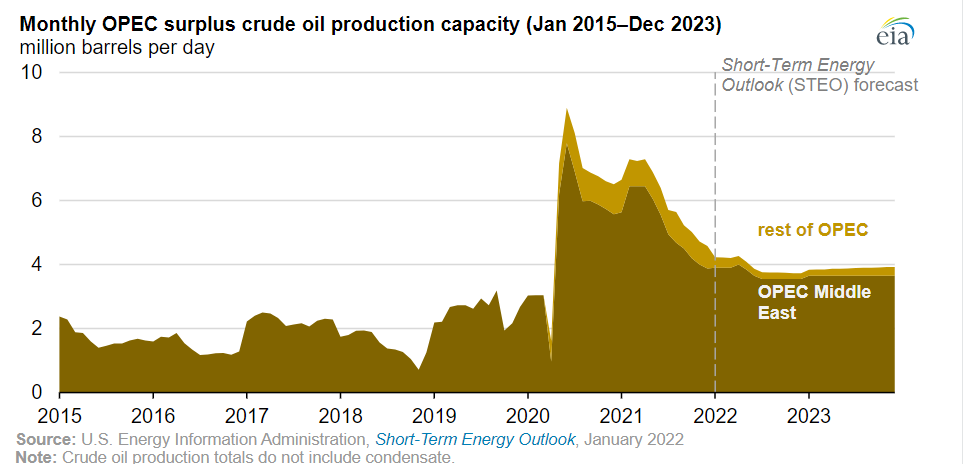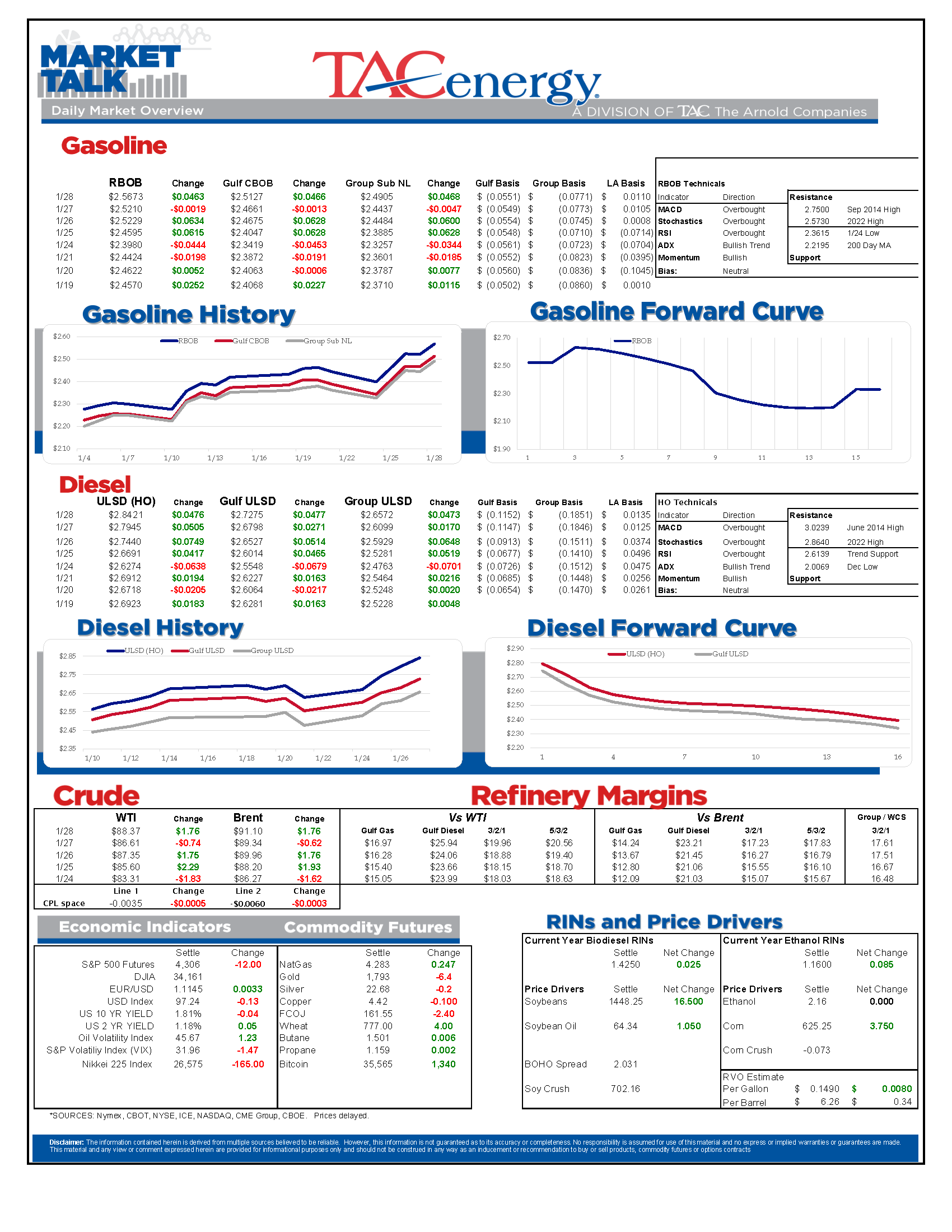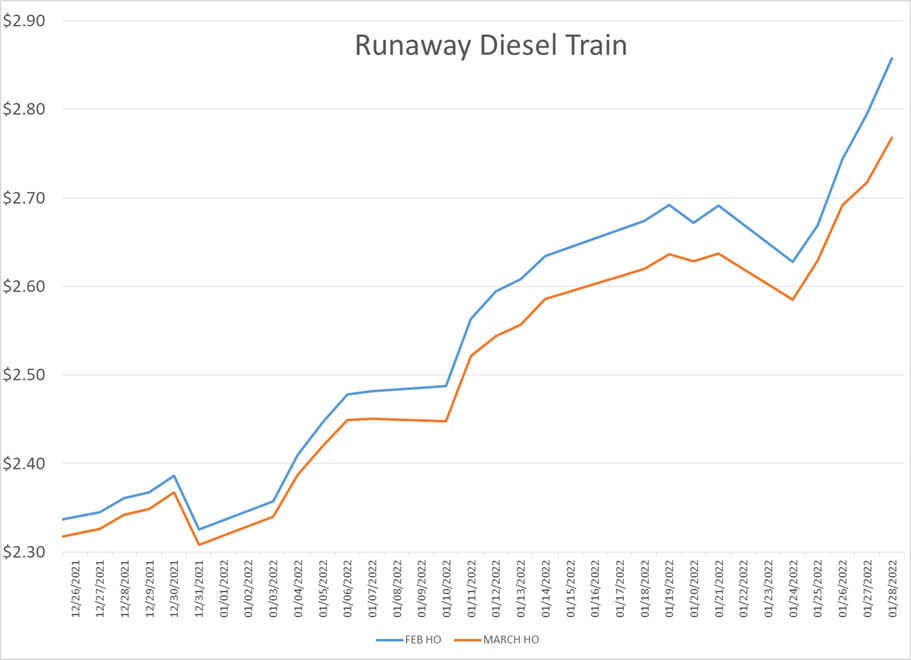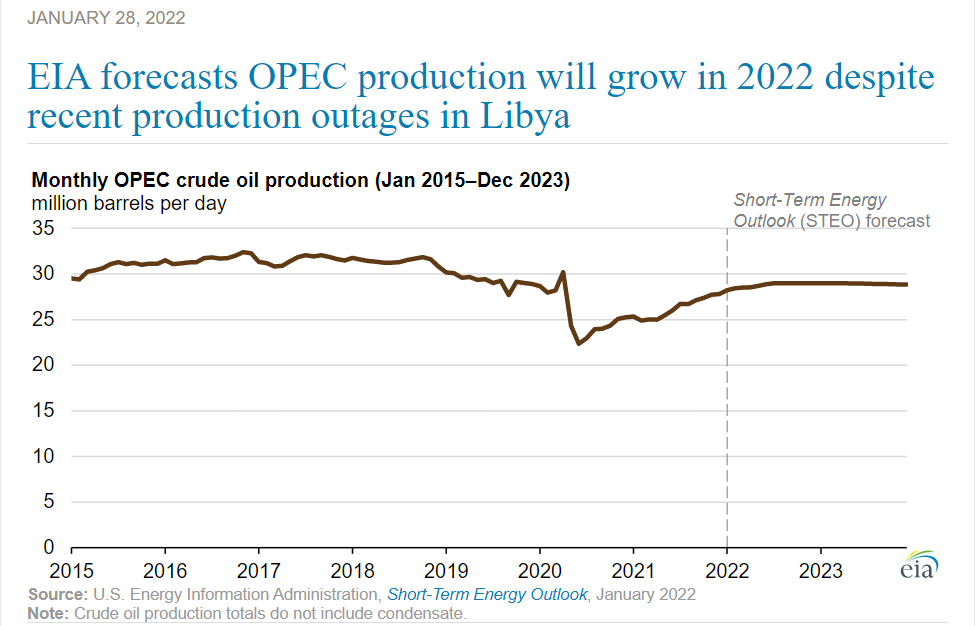Brewing Storms, Both Literal And Figurative Are Stirring Up Energy Markets For A 4th Straight Day

Brewing storms, both literal and figurative are stirring up energy markets for a 4th straight day, sending refined products and WTI to yet another round of 7 year highs this morning.
A powerful winter storm is heading for the east coast, and the “Bomb Cyclone” warnings have sparked a round of panic buying that we haven’t witness since the dreaded Polar Vortex of 2014, which was (coincidentally?) the last time fuel prices were this high. Why gasoline prices are joining the run up this morning when so millions of cars will be unable to drive for days is always a bit of a mystery, but once the snowball effect of buying in energy markets gets rolling, all bets are off.
Speaking of which, the February Heating Oil contract – which expires Monday – is breaking free from the pack of surging energy prices, trading 9 cents higher than the March contract this morning north of $2.86, a gain of 26 cents since last Friday. With less than 2 days until expiration, don’t be surprised to see some even more volatile swings in that contract, and a spike to $3 in the next two sessions is a real possibility.
Meanwhile, the figurative storm brewing around the Ukraine continues, with more signs of escalation keeping markets on edge. The US is working with energy producers to come up with backup plans to supply Europe with supplemental fuel should Russia continue to use its Natural Gas and Oil exports as its most powerful weapon in this war.
Help is on the way? A big story over the past several months was the expectation that OPEC and other producers would regain the upper hand and global oil supplies would begin building again after an 18 month decline. So far that hasn’t proved true as various disruptions and supply chain bottlenecks have limited output. The EIA this morning published a note doubling down on the theory that OPEC’s production will have its largest increase in nearly 20 years despite the headwinds in Libya and elsewhere, which may eventually help prices to collapse back to more comfortable levels. The big question in the meantime is how high will they spike until the supply reinforcements arrive later in the year.
While the world anxiously awaits a solution to the lack of adequate petroleum supplies in 2022, the even slower supply race for a lower carbon energy solution continues with plenty of new ideas hitting the market daily, but little if anything that will change the outlook soon. Yesterday we saw word from Valero that Sustainable Aviation Fuels were still not economically viable, particularly given the competition for renewable feedstocks, and a report that Marathon was considering buying the idled P66 refinery in LA to convert it to renewable production, which will continue to add pressure on the feedstock market if it actually happens.
Click here to download a PDF of today's TACenergy Market Talk.
News & Views
View All
The Recovery Rally In Energy Markets Continues For A 3rd Day
The recovery rally in energy markets continues for a 3rd day with refined product futures both up more than a dime off of the multi-month lows we saw Wednesday morning. The DJIA broke 40,000 for the first time ever Thursday, and while it pulled back yesterday, US equity futures are suggesting the market will open north of that mark this morning, adding to the sends of optimism in the market.
Despite the bounce in the back half of the week, the weekly charts for both RBOB and ULSD are still painting a bearish outlook with a lower high and lower low set this week unless the early rally this morning can pick up steam in the afternoon. It does seem like the cycle of liquidation from hedge funds has ended however, so it would appear to be less likely that we’ll see another test of technical support near term after this bounce.
Ukraine hit another Russian refinery with a drone strike overnight, sparking a fire at Rosneft’s 240mb/day Tuapse facility on the black sea. That plant was one of the first to be struck by Ukrainian drones back in January and had just completed repairs from that strike in April. The attack was just one part of the largest drone attack to date on Russian energy infrastructure overnight, with more than 100 drones targeting power plants, fuel terminals and two different ports on the Black Sea. I guess that means Ukraine continues to politely ignore the White House request to stop blowing up energy infrastructure in Russia.
Elsewhere in the world where lots of things are being blown up: Several reports of a drone attack in Israel’s largest refining complex (just under 200kbd) made the rounds Thursday, although it remains unclear how much of that is propaganda by the attackers and if any impact was made on production.
The LA market had 2 different refinery upsets Thursday. Marathon reported an upset at the Carson section of its Los Angeles refinery in the morning (the Carson facility was combined with the Wilmington refinery in 2019 and now reports as a single unit to the state, but separately to the AQMD) and Chevron noted a “planned” flaring event Thursday afternoon. Diesel basis values in the region jumped 6 cents during the day. Chicago diesel basis also staged a recovery rally after differentials dropped past a 30 cent discount to futures earlier in the week, pushing wholesale values briefly below $2.10/gallon.
So far there haven’t been any reports of refinery disruptions from the severe weather than swept across the Houston area Thursday. Valero did report a weather-related upset at its Mckee refinery in the TX panhandle, although it appears they avoided having to take any units offline due to that event.
The Panama Canal Authority announced it was increasing its daily ship transit level to 31 from 24 as water levels in the region have recovered following more than a year of restrictions. That’s still lower than the 39 ships/day rate at the peak in 2021, but far better than the low of 18 ships per day that choked transit last year.
Click here to download a PDF of today's TACenergy Market Talk.

Energy Prices Found A Temporary Floor After Hitting New Multi-Month Lows Wednesday
Energy prices found a temporary floor after hitting new multi-month lows Wednesday morning as a rally to record highs in US equity markets and a modestly bullish DOE report both seemed to encourage buyers to step back into the ring.
RBOB and ULSD futures both bounced more than 6 cents off of their morning lows, following a CPI report that eased inflation fears and boosted hopes for the stock market’s obsession of the FED cutting interest rates. Even though the correlation between energy prices and equities and currencies has been weak lately, the spillover effect on the bidding was clear from the timing of the moves Wednesday.
The DOE’s weekly report seemed to add to the optimism seen in equity markets as healthy increases in the government’s demand estimates kept product inventories from building despite increased refinery runs.
PADD 3 diesel stocks dropped after large increases in each of the past 3 weeks pushed inventories from the low end of their seasonal range to average levels. PADD 2 inventories remain well above average which helps explain the slump in mid-continent basis values over the past week. Diesel demand showed a nice recovery on the week and would actually be above the 5 year average if the 5% or so of US consumption that’s transitioned to RD was included in these figures.
Gasoline inventories are following typical seasonal patterns except on the West Coast where a surge in imports helped inventories recover for a 3rd straight week following April’s big basis rally.
Refiners for the most part are also following the seasonal script, ramping up output as we approach the peak driving demand season which unofficially kicks off in 10 days. PADD 2 refiners didn’t seem to be learning any lessons from last year’s basis collapse and rapidly increased run rates last week, which is another contributor to the weakness in midwestern cash markets. One difference this year for PADD 2 refiners is the new Transmountain pipeline system has eroded some of their buying advantage for Canadian crude grades, although those spreads so far haven’t shrunk as much as some had feared.
Meanwhile, wildfires are threatening Canada’s largest oil sands hub Ft. McMurray Alberta, and more than 6,000 people have been forced to evacuate the area. So far no production disruptions have been reported, but you may recall that fires in this region shut in more than 1 million barrels/day of production in 2016, which helped oil prices recover from their slump below $30/barrel.
California’s Air Resources Board announced it was indefinitely delaying its latest California Carbon Allowance (CCA) auction – in the middle of the auction - due to technical difficulties, with no word yet from the agency when bidders’ security payments will be returned, which is pretty much a nice microcosm for the entire Cap & Trade program those credits enable.




